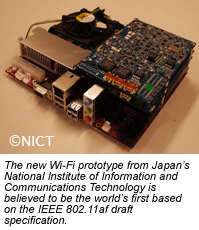Japan’s NITC develops Wi-Fi prototype for TV white space use
Japan’s National Institute of Information and Communications Technology (NICT) has developed what is believed to be the world's first Wi-Fi prototype in TV White Spaces (TVWS) based on the IEEE 802.11af draft specification.
IEEE 802.11af is currently the only task group (TG) under the IEEE 802.11 working group for Wi-Fi technologies in the TVWS — channels in the television band between 470MHz and 710MHz that are unused in given locales. The developed system is the first prototype that verifies the physical (PHY) and media access control (MAC) layer design of the draft specification, following the worldwide trend of prompting the TVWS for wireless communication systems.

Around the world, government regulators have launched initiatives to make more efficient use of spectrum. In the United States, the FCC has changed its rules to allow unlicensed RF devices to transmit in TV white spaces, provided they comply with rules set up to prevent interference to broadcast signals.
Wireless mics and other low-power auxiliary transmitters used for remote newsgathering, sports coverage and by the entertainment industry also transmit in TV white spaces. The FCC has set up two channels in the UHF band near channel 37 for wireless mic use at major event and production venues to protect them from white space devices. But given the ad hoc nature of remote TV news coverage from unpredictable locations, use of white spaces by unlicensed devices has remained a concern.
IEEE 802.11af TG was formed in 2009 under IEEE 802.11 WG. The target is to define modifications to both the 802.11 PHY and MAC layers to meet the legal requirements for channel access and coexistence in the TVWS. In September 2012, the 802.11af released its first stable draft standard (Draft 2.0). NICT is one of the most active contributors and leading parties of the 802.11af.
The NICT prototype verifies the physical (PHY) and medium access control (MAC) layer design of the draft specification. One of the OFDM PHY modes that take a single 6MHz TV channel to operate is implemented with transmission power of 20dBm. The prototype has an interface and co-worked with the White Space Data Base (WSDB) developed by NICT and the full MAC specification of the secured protocol is implemented for primary user (licensed TV broadcaster) protections.
The prototype works with the Registered Location Secure Server (RLSS) that is defined in the 802.11af draft standard to avoid interference with other white space users (secondary users). NICT has developed a RLSS server.
Get the TV Tech Newsletter
The professional video industry's #1 source for news, trends and product and tech information. Sign up below.
